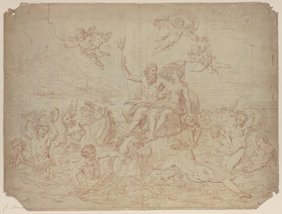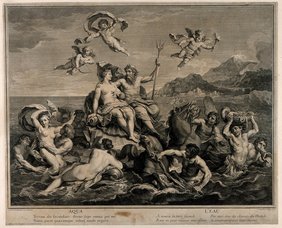Neptune and Amphitrite are enthroned on a shell-shaped chariot drawn by hippocamps. Neptune embraces Amphitrite's shoulders with his left hand, holding the trident in his right. While the couple seems to remain in mutual, intimate contemplation, they are accompanied by Nereids and Tritons in all the more lively play. The motif goes back to a painting from a series of allegories of the four elements by the French painter Louis de Boullogne the Younger (1654-1733), director of the Académie and Premier Peintre du Roi (from 1725), created at the beginning of the 18th century. While the whereabouts of the paintings have been unknown since the early 19th century, Boullogne's compositions have survived through preserved preparatory drawings (Département des Arts graphiques, Louvre) and four copper engravings. They were published in Paris between 1718 and 1721 by Louis Desplaces (1682-1739), who himself executed the elements "Fire" and "Water". "Air" and "Earth" were engraved by Charles Dupuis (1685-1742).
The present sheet is to be regarded as a preparatory drawing for the execution of the allegory of water in copper engraving, and was possibly even used for the transfer to the plate. This is indicated by the reversed orientation of the engraving, the corresponding measurements of drawing and print and the accuracy of details; the partly clearly traced contours of the figures can also be recognised. Due to the precarious condition of the sheet, it was stabilised from the back with paper sheets at an unknown time. Therefore the verso of the drawing and possible traces of transfer are no longer detectable.
On the backing board, the sheet was given to the painter François Boucher (1703-1770), who was about two generations younger - an attribution that has become obsolete through the identification of the motif. The drawings by Louis de Boullogne preserved in the Louvre are sketches and studies for the paintings of the four elements, particularly numerous are those for the Allegory of Water (Guicharnaud 1985). They were executed on blue paper in charcoal with white heightening and, when compared with the sheet in the Haupt Collection, show only minimal differences, such as in the physiognomies of the Tritons (e.g. inv. 24854, 24855, 24860). Despite the different technique, a stylistic closeness to the present drawing can certainly be detected. Since the participants of the creation process are precisely identified on the engraving and Boullogne is named as inventor and painter, but not as draughtsman, it can be assumed that the sheet in the Albrecht Haupt Collection is not his own work. However, it is quite conceivable that the Boullogne’s sketches were available to the draughtsman for the execution of this drawing.
Birte Rubach


